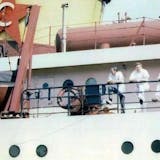ST. VINCENT, Minn. — A 15-passenger van with Missouri plates trundled down a dirt road in a January blizzard, miles from anything except the Canadian boundary. To a U.S. Border Patrol agent monitoring the frozen farm fields of far northwestern Minnesota, it was suspicious but not surprising.
He already knew this was a spot for human smuggling.
Weeks earlier, authorities on the Canadian side of the border had discovered a backpack containing a price tag in rupees, India’s currency. Border Patrol agents saw footprints in the snow that day, then twice more in the next month. They knew something illegal was going on.
But that January morning, they didn’t expect the gruesome discovery they made later as a result of stopping the van: a family of four, frozen to death just yards short of the border — a tragedy that made international headlines.
Though attention has long focused on illegal crossings of the southern border, the path of least resistance for some smuggling operations is through the north, where the border is twice as long with an eighth as many agents patrolling.
Agents caught smugglers bringing a small stream of Nigerians into Canada a few hundred miles west of here several years ago. Recently, they have seen a string of Indian nationals and Romanians crossing into the United States.
While traversing miles of barren tundra or swampy forests may sound ineffective and dangerous, Border Patrol agents say northern crossings are more common than Americans would guess.
“We’re just looking for things that look different: footprints, vehicle tracks, a torn-down fence,” said Scott Good, chief patrol agent of the Grand Forks sector, which covers 861 miles of the northern border with fewer than 200 agents. “You’re really in the middle of nowhere, lots of places to get lost, no phone signal. It’s a rough, treacherous place.”


